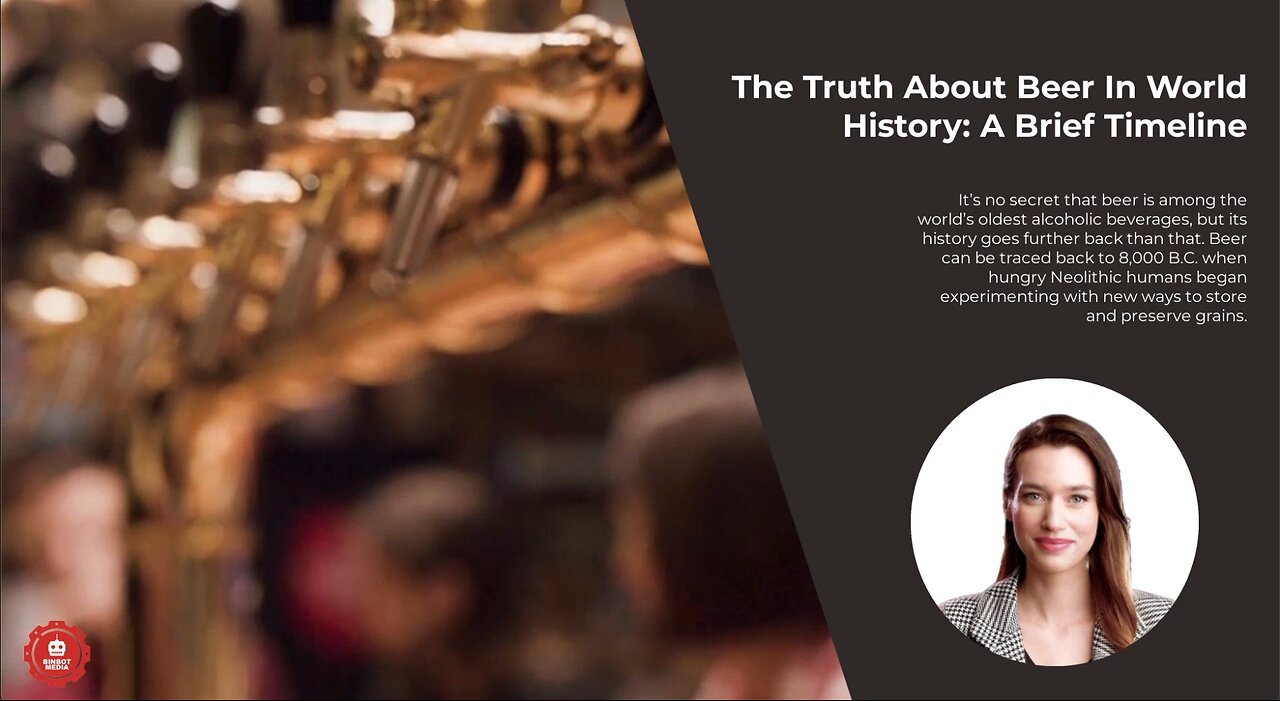Premium Only Content

The Truth About Beer In World History: A Brief Timeline
The history of beer is as vast and varied as the different types of beer out there. It’s no secret that beer is among the world’s oldest alcoholic beverages, but its history goes further back than that. Beer can be traced back to 8,000 B.C. when hungry Neolithic humans began experimenting with new ways to store and preserve grains. From there, we explored its many variations over time, including early fermentation practices in ancient Egypt, Mesopotamia, and China. So if you think you know everything about beer in world history, think again… Let’s get started.
8,000 B.C. – Early Beer in the Neolithic Era
The earliest archaeological evidence of beer was found in a Neolithic village in Iran and dates back to 8000 B.C. The villagers fermented barley with wild yeast to make beer as early as the Neolithic era. However, it’s difficult to say whether the beer was drunk for nutrition, medicinal purposes, or as a social beverage. There is also evidence that people in Mesopotamia, China, and India were brewing beer up to 5,000 years ago. When we look at the archaeological evidence for beer, there are three key ingredients we should keep in mind: cereals (like barley, wheat, or corn), water, and yeast. Early beer was made with a combination of three ingredients. There is evidence that beer was being made in the Middle East and Europe around this time.
3,000 B.C. – Mesopotamian Brewed Beers
The brewing tradition in Ancient Mesopotamia (modern-day Iraq) began around the fifth millennium B.C. The Sumerians, the first civilization in the region, were responsible for creating the world’s earliest brewed beer. Brewing in this region, especially in southern Mesopotamia, was a domestic activity, conducted by women at home. The Sumerians did not have a written language at this point, but we know they were brewing beer because they left behind clay artifacts that depict the brewing process. The brewing process was long and involved, but it was very similar to brewing practices today. First, women would select the grains—typically barley or emmer wheat. Next, they would grind the grains, most likely between stones. Then, they would add water and let the mixture sit and ferment.
-----------------------------------------------------------------------------
Fun and unique beer t-shirts for beer lovers and home brewers alike. Grab one today.
MENS':
https://rb.gy/eravbq
WOMEN'S:
https://rb.gy/8k3qhm
------------------------------------------------------------------------------
1,000 A.D. – Ancient Egyptian Beer
The Ancient Egyptians were brewing beer as early as the 15th century B.C. For the Ancient Egyptians, beer was an integral part of their daily lives. It was a common beverage for both rich and poor Egyptians—even children drank beer. Egyptians brewed beer with a wide variety of additives, including dates, honey, herbs, and spices. They also made two different types of beer: one was unfiltered, high in alcohol content, and drunk in small quantities; the other was filtered and low in alcohol content and was more of a daily staple. According to written records, the Ancient Egyptians were very advanced in terms of brewing technology. They were using specialized tools, including a type of vat, to make beer. They also created yeast by baking bread, which they then used to start the fermentation. To make the beer even more nutritious, they used a special filtering process that left behind the yeast, which is very high in protein.
600-1400 A.D. - Early European Beers
The earliest written evidence for European brewing comes from 6th-century Ireland, where monasteries produced beer as a way to earn money. From there, brewing spread throughout Europe, with each region developing its own methods. In England, for example, brewers were using hops as a preservative by the late 1200s, which led to the development of what we now consider traditional English ales. In Germany, breweries were making lagers, which are fermented at cooler temperatures and tend to be less alcoholic than ales. Lagers became popular during the Industrial Revolution because they were easier to store because of their lower alcohol content.
16th Century – The Reinheitsgebot
The Reinheitsgebot, or “purity law,” is a German beer law that was first put in place in 1516. This law declared that only water, barley, and hops could be used to make beer. The law was originally intended to protect consumers from bad beer, but it had the unfortunate side effect of encouraging the use of barley, which led to the rise of cheap, low-quality beer. The law was updated in 1906 to allow German breweries to also use yeast, and again in 2007 to allow the use of certain types of spices and fruits. In 2017, Bavaria repealed its own version of the Reinheitsgebot, and now German breweries are allowed to use any ingredients they want to make beer.
19th Century to Today - Industrialization of Beer
With advances in technology, the 19th century saw a major shift in the production of beer. Up until this point, most beers were still being produced at home. With the spread of industrialization, large companies took over beer production. In the U.S., the rise of commercial breweries happened around the same time as the Civil War. The U.S. now produces almost as much beer as is consumed in the country, with around 98 percent of it being produced by large-scale commercial breweries. Today, there are more than 5,000 types of beer available. There are even beer-based cocktails, like the shandy and michelada, that combine different flavors of beer with other beverages like lemonade or tomato juice. There are many different ways to explore the history of beer, including visiting a brewery and tasting different types of beer.
Conclusion
Beer has a rich history that dates back thousands of years. From the Neolithic era to the Industrial Revolution, brewers have been experimenting with new ingredients and production methods to create new and different varieties of beer. While most modern varieties are available today, others have disappeared over time, and we can only hope they will make a comeback someday. When it comes to beer, it’s more important than ever to be informed, consumers. There are many different types of beer available, and the more you know about the history of beer, the better you’ll be able to navigate the modern beer landscape.
-
 2:07:26
2:07:26
Kim Iversen
5 hours agoFAFO: Trump's ‘Deport or Get Tariff’d’ Plan Worked | Did Trump Reveal The REAL Gaza Death Toll?
27.2K71 -
 LIVE
LIVE
Danny Polishchuk
10 hours agoDeportations Begin + Guest Jay Dyer | Low Value Mail Live Call In Show
1,534 watching -
 1:10:08
1:10:08
Donald Trump Jr.
7 hours agoWhat Real Leadership Looks Like, Live with Sen Bernie Moreno | TRIGGERED Ep.210
122K205 -
 1:38:57
1:38:57
Glenn Greenwald
6 hours agoWith Tulsi's Hearing this Week, Establishment Attacks her with Lies About Snowden & 702; U.S. Journalist Arrested in Switzerland for Criticizing Israel; China's Leap Forward in AI | SYSTEM UPDATE #397
55.7K73 -
 57:43
57:43
The StoneZONE with Roger Stone
3 hours agoWhat Will The JFK Assassination Files Reveal? | The StoneZONE w/ Roger Stone
19K8 -
 18:24
18:24
Tundra Tactical
6 hours ago $0.36 earnedWhats New With HRT Tactical Gear at SHOT Show 2025
39.8K5 -
 23:27
23:27
Rethinking the Dollar
5 hours agoWealth Protection SECRETS Learned from Wildfires w/ Paul Stone
36.6K4 -
 59:28
59:28
Flyover Conservatives
21 hours agoInsider Reacts to Trump’s 100 Hours: Davos, WHO, Climate Change, DEI… - Alex Newman | FOC Show
17.6K1 -
 1:04:30
1:04:30
Battleground with Sean Parnell
9 hours agoPresident Trump Is Flooding The Zone
104K10 -
 LIVE
LIVE
We Like Shooting
15 hours agoWe Like Shooting 595 (Gun Podcast)
167 watching